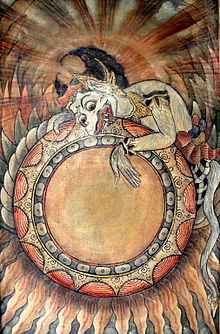Grahana (Sanskrit: ग्रहणं, romanized: Grahaṇam, lit. 'Eclipse') refers to the Sanskrit term for an eclipse.[1] Eclipses are regarded to be noteworthy phenomena in Hinduism, and legends involving their origin and purpose are featured in Hindu mythology.

Literature edit
An eclipse is classified as either as Suryagrahana (Sūryagrahaṇam), a solar eclipse, or a Chandragrahana (Candragrahaṇam), a lunar eclipse in Hindu literature.[2]
Beliefs surrounding eclipses are regarded by scholars to be closely associated with Vedic deities, and were significant in both astrology and astronomy.[3][4] The origin of eclipses is explained in the Puranic legend of the Samudra Manthana, the churning of the ocean. When the asura named Rahu attempted to pose as a deva to receive amṛtam, the nectar of eternal life, Surya and Chandra, the deities of the Sun and the Moon, alerted Mohini, the incarnation of Vishnu. Mohini promptly employed her discus to behead the asura, but he had already partaken the nectar, and had become immortal. Rahu's head was exiled to the heavens, and due to the two celestial deities' part in his decapitation, he is said to occasionally swallow them whole for a given period of time, causing the solar and the lunar eclipse.[5]
in other texts, the eclipse is associated with Svarbhanu, who is sometimes identified as the asura whose head became Rahu. According to the Mahabharata, the sun god Surya is also described as an "enemy of Svarbhānu".[6] Svarbhānu was said to strike both the Sun and Moon with arrows, the celestial bodies being revived by Atri as in the Rigveda.[7]
The Skanda Purana recounts a legend where sages witness a forest-dwelling woman transform into a beauty after taking a bath in a holy lake during a solar eclipse, implying that it is a means of attaining salvation.[8]
In the Padma Purana, it is stated that a man who offers water to his ancestors during a solar eclipse nourishes them, and achieves heaven; failing thus, he becomes a Chandala. This is because all water is said to be as holy as the Ganges during this period. All Brahmins become as venerable as the Sage Vyasa during this period. A present that is offered during a lunar eclipse is 100,000 effective; a present that is offered during a solar eclipse is 1,000,000 effective.[9]
The Narada Purana offers computations regarding the predictions of solar and lunar eclipses, along with other astronomical events.[10]
The Brahma Vaivarta Purana states that one who bathes during a full moon, an eclipse, and sacred occasions achieve the abode of Vishnu, Vaikuntha.[11]
Religious practices edit
Hindus generally believe that a grahana is an ill-omen, and undertake certain activities before, during, or after its onset. Before a solar eclipse, fasting is sometimes practised for up to six hours prior to the phenomenon. Food is often prepared only after the passing of the eclipse, and conventions regarding consuming meals at given hours in the context of the event are prescribed in the Kurma Purana.[12] During the first and the final phases of an eclipse, a practising Hindu might ritually bathe to cleanse oneself, as well as offer prayers to one's ancestors. Pilgrimage sites situated adjacent to a river throng with devotees during the onset of a grahana in some regions.[13] Pregnant women are considered to be especially at risk to the effects of an eclipse, and are expected to adhere more strictly to religious bans during the phenomenon to prevent birth deformities in their children.[14] It is regarded to be an ill-omen to be born during an eclipse, and Brahmins are often called upon to ritually bless such an individual. On the other hand, a grahana is considered to be an auspicious time to practise chanting mantras that are believed to ward against evil.[15]
See also edit
References edit
- ^ Hog, Trebor (2018-05-05). Sanskrit English Lexicon (in Sanskrit). Truth Limited. p. 70.
- ^ Parmeshwaranand, Swami (2001). Encyclopaedic Dictionary of Puranas. Sarup & Sons. p. 82. ISBN 978-81-7625-226-3.
- ^ Garg, Gaṅgā Rām (1992). Encyclopaedia of the Hindu World. Concept Publishing Company. p. 11. ISBN 978-81-7022-374-0.
- ^ Thompson, Richard L. (2004). Vedic Cosmography and Astronomy. Motilal Banarsidass Publ. p. 100. ISBN 978-81-208-1954-2.
- ^ Venkatesananda, Swami (1989-08-03). The Concise Srimad Bhagavatam. SUNY Press. p. 195. ISBN 978-0-7914-0149-1.
- ^ Buitenen, Johannes Adrianus Bernardus; Buitenen, J. A. B. van (1981-09-15). The Mahabharata, Volume 2: Book 2: The Book of Assembly; Book 3: The Book of the Forest. University of Chicago Press. p. 242. ISBN 978-0-226-84664-4.
- ^ Kiehnle, Catharina (May 1999). "Dattātreya: The Immortal Guru, Yogin, and Avatāra: A Study of the Transformative and Inclusive Character of a Multi-Faceted Hindu Deity. By Antonio Rigopoulos. SUNY Series in Religious Studies. Edited by Harold Coward. Albany: State University of New York Press, 1998. xvi, 342 pp". The Journal of Asian Studies. 58 (2): 3–4. doi:10.2307/2659472. ISSN 0021-9118. JSTOR 2659472. S2CID 249919053.
- ^ Jain, Sandhya (2022-03-19). Adi Deo Arya Devata: A Panoramic View oF Tribal-Hindu Cultural Interface. Notion Press. p. 36. ISBN 979-8-88530-378-1.
- ^ Bhatt, Dr G. P.; Deshpande, Dr N. A. (2013-01-01). The Padma-Purana Part 2: Ancient Indian Tradition and Mythology Volume 40. Motilal Banarsidass. p. 715. ISBN 978-81-208-3907-6.
- ^ Tagare, Ganesh Vasudeo (1981-01-01). The Narada-Purana Part 2: Ancient Indian Tradition and Mythology Volume 16. Motilal Banarsidass. p. 711. ISBN 978-81-208-0348-0.
- ^ Books, Kausiki (2021-07-09). Brahma Vaivartha Purana: 2 Prakrithi Khanda: English Translation only without Slokas: English Translation only without Slokas. Kausiki Books. p. 57.
- ^ Books, Kausiki (2021-10-24). Kurma Purana Part 2: English Translation only without Slokas. Kausiki Books. p. 169.
- ^ Lall, R. Manohar (2004). Among the Hindus: A Study of Hindu Festivals. Asian Educational Services. p. 104. ISBN 978-81-206-1822-0.
- ^ Simoons, Frederick J. (1998). Plants of Life, Plants of Death. Univ of Wisconsin Press. p. 171. ISBN 978-0-299-15904-7.
- ^ Sastri, S. M. Natesa (1903). Hindu Feasts, Fasts and Ceremonies. Printed at the M.E. publishing house. p. 31.